In a surprising pivot from its 2020 stance on halting new hydroelectric projects, Costa Rica, through the Costa Rican Electricity Institute (ICE), has unveiled plans to embark on the construction of a new hydroelectric plant on the Reventazón River, located in the quaint town of Fourth Cliff. The announcement made by Marco Acuña Mora, ICE’s executive president, outlines a project with an estimated investment of $291 million, aiming to bolster the nation’s renewable energy portfolio.
A Shift in Energy Strategy
This move marks a significant shift from the previous moratorium on new hydroelectric facilities, which was set to last until 2027 to allow for environmental and economic reassessment. ICE’s decision to forge ahead with the development of a second plant on the Reventazón River raises both anticipation and concern, signaling a complex balancing act between advancing sustainable energy goals and navigating the environmental challenges posed by climate change.
The Path Ahead: An Idea Awaiting Validation
Currently, the proposal for the new hydroelectric plant remains in the conceptual phase, with pre-feasibility studies yet to be conducted. This crucial step will determine the project’s viability, environmental impact, and financial sustainability. As ICE ventures into this ambitious undertaking, the project faces scrutiny from various quarters, highlighting the need for thorough analysis and strategic planning.
Climate Change: A Looming Challenge for Hydroelectric Production
A report from the International Energy Agency casts a shadow on the future of hydroelectric projects in the context of climate change. Predictions of reduced rainfall and runoff could jeopardize the operational viability of hydroelectric plants, suggesting a heightened level of risk for investments in such infrastructure. This backdrop of environmental uncertainty underscores the importance of incorporating climate resilience into the planning and execution of renewable energy projects.
Economic Viability and Comparative Costs
Concerns regarding the economic feasibility of the new hydroelectric plant have been voiced by industry stakeholders, including Carlos Montenegro, executive director of the Chamber of Industries of Costa Rica. Montenegro highlights a historical pattern where ICE’s projects escalate in cost, often ending up two to three times higher than initial estimates. Moreover, the energy cost produced by the proposed plant is projected to be double that of hydroelectric facilities in neighboring countries, raising questions about competitive pricing and financial prudence.
Navigating a Sustainable Energy Future
As Costa Rica forges ahead with its hydroelectric ambitions on the Reventazón River, the project embodies the nation’s commitment to renewable energy and environmental stewardship. However, it also presents a complex array of challenges, from ensuring economic viability to addressing the environmental implications of climate change.
The journey towards constructing the new plant at Fourth Cliff will require a multifaceted approach, blending technological innovation, environmental sensitivity, and economic pragmatism. With the global community watching, Costa Rica’s endeavor could set a precedent for how nations harness the power of natural resources while safeguarding the planet for future generations.


1 comment
[…] Source link […]